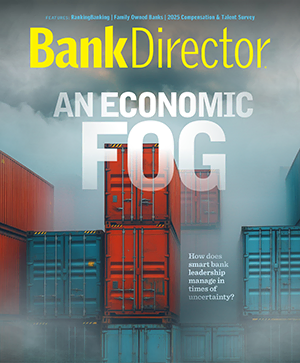
Dismantling Problematic Partnerships
When entering a new third-party partnership, banks should develop a plan to manage issues as they arise and the fallout if the partnership fails.
Brought to you by Barack Ferrazzano Kirschbaum & Nagelberg LLP

*This article was published in Bank Director magazine’s fourth quarter 2024 issue.
Jobs and Wozniak, Lennon and McCartney, or Jordan and Pippen. All great combinations. None lacking friction, strife or competing interests. Like these prolific partners, when banks work with fintechs, software providers and service providers, the results can elevate the bank, end badly or, oftentimes, both. So, what are banks to do when a relationship turns sour? To begin, banks should consider the following lessons learned from the fallout of fintech partnerships past.
1. Know Your Rights
Many contractual protections seem superfluous — until you need them. When faced with a failing partnership, banks should revisit myriad key clauses and questions, which hopefully they adequately addressed in the initial agreement, such as:
- Rights to terminate: Does your institution have grounds for termination? What constitutes an event of default? Is your partner allowed to cure? How long is the cure period? Is there an early termination penalty? Is there a period of exclusivity that survives a termination?
- Indemnification, insurance and limitations of liability: Can your institution recover the losses caused by your partner’s actions or omissions? Will you be able to recover attorney’s fees and costs? Does your partner have the financial means to reimburse you for any losses? Are there other third-party sources of recovery?
- Notice: How do you provide notice? Who are the decision-makers at your counterparty?
Effect of termination: How will customer information be protected? How will a transition to a new partner or vendor be completed? What actions need to be taken to complete either a transition or a wind-down?
Having a plan that is consistent with your bank’s underlying contractual rights is key to quickly and efficiently ending or rehabilitating your relationship.
2. Anticipate the End
Too often, banks fail to continue evaluating counterparties after executing an agreement. Diligence should not end at deal signing. Your bank needs to communicate with partners and vendors over the course of the relationship so it knows when problems arise. An annual partner review is often too late.
3. Prepare to Pivot
Knowing your contractual rights and appreciating your partner’s situation will allow you to take the next steps that will help your institution ensure continuity and the ability to continue serving customers. Banks, for example, can prepare for a partner’s demise by ensuring redundancy. You can consider retaining a backup servicer if your partner services your credit card or loan portfolio. If you utilize a payments processor, what other processors exist? Monitoring and evaluating alternative partners and providers ensures your bank will not be left in a lurch.
Similarly, if your partner experiences financial trouble, there are multiple protective measures you might pursue. Requiring or increasing your partner’s reserve account, requiring a letter of credit or even exercising your set-off rights can all prove essential.
4. Document Everything
An old litigation partner of ours used to chide clients with the phrase, “If you can’t prove it, it didn’t happen.” Documenting your expectations, your evaluations and your partner’s missteps and misdeeds may help prove to a court or a regulator that your partner, not your bank, is to blame for any troubles. Regulators’ increased focus on third- and fourth-party oversight portends the need to document what the bank did to identify its partner’s failings and what proactive measures the bank took to address them. Documenting your oversight and response may save the bank from adverse regulatory action.
5. Do Not Fear Disputes (or Dispute Resolution)
Litigation is not always the right option — but it should be an option that banks at least consider when a partnership dissolves. Depending on your partner’s financial wherewithal, the strength of your claims and other factors, the noncombative route can sometimes cost your bank thousands or even millions of dollars of a potential recovery. There may be even greater incentive for banks to pursue an adversarial action if their agreement contains a prevailing party or other fee-shifting mechanism.
A messy divorce can mar even the most dynamic of duos (or groups). By heeding these lessons, you may not be able to avoid trouble, but these lessons may help you manage partnership issues when they arise and the fallout when the partnership fails.



